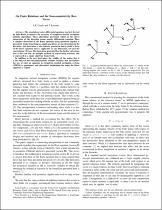JavaScript is disabled for your browser. Some features of this site may not work without it.
- ResearchSpace
- →
- Research Publications/Outputs
- →
- Journal Articles
- →
- View Item
| dc.contributor.author |
Candy, LP

|
|
| dc.contributor.author |
Lasenby, J

|
|
| dc.date.accessioned | 2012-04-11T15:52:36Z | |
| dc.date.available | 2012-04-11T15:52:36Z | |
| dc.date.issued | 2010-04 | |
| dc.identifier.citation | Candy, LP and Lasenby, J. 2010. On finite rotations and the noncommutativity rate vector. IEEE Transactions on Aerospace and Electronic Systems, vol. 46(2), pp 938-943 | en_US |
| dc.identifier.issn | 0018-9251 | |
| dc.identifier.uri | http://ieeexplore.ieee.org/xpl/login.jsp?tp=&arnumber=5461669&url=http%3A%2F%2Fieeexplore.ieee.org%2Fstamp%2Fstamp.jsp%3Ftp%3D%26arnumber%3D5461669 | |
| dc.identifier.uri | http://hdl.handle.net/10204/5740 | |
| dc.description | Copyright: 2010 IEEE. This is the post-print version of the work. The definitive version is published in IEEE Transactions on Aerospace and Electronic Systems, vol. 46(2), pp 938-943. Personal use of this material is permitted. Permission from IEEE must be obtained for all other users, including reprinting/ republishing this material for advertising or promotional purposes, creating new collective works for resale or redistribution to servers or lists, or reuse of any copyrighted components of this work in other works. | en_US |
| dc.description.abstract | The orientation vector differential equation was first derived by John Bortz to improve the accuracy of strapdown inertial navigation attitude algorithms. These algorithms previously relied on the direct integration of the direction cosine matrix differential equation. Here a compact derivation of the Bortz equation using geometric algebra is presented. Aside from being as simple and direct as any derivation in the literature, this derivation is also entirely general in that it yields a form of the Bortz equation that is applicable in any dimension, not just the conventional 3D case. The derivation presented has the further advantage that it does not rely on multiple methods of representing rotations and is expressed in a single algebraic framework. In addition to the new derivation, the validity of the notion that it is the effect of the noncommutativity of finite rotations that necessitates the use of such an equation in strapdown inertial navigation systems (SDINS) is questioned, and alternative justification for using the Bortz equation is argued. | en_US |
| dc.language.iso | en | en_US |
| dc.publisher | IEEE | en_US |
| dc.relation.ispartofseries | Workflow;6177 | |
| dc.subject | Geometric algebra | en_US |
| dc.subject | Rotation vector | en_US |
| dc.subject | Inertial navigation | en_US |
| dc.subject | Finite rotations | en_US |
| dc.subject | Finite rotations | en_US |
| dc.subject | Bortz | en_US |
| dc.title | On finite rotations and the noncommutativity rate vector | en_US |
| dc.type | Article | en_US |
| dc.identifier.apacitation | Candy, L., & Lasenby, J. (2010). On finite rotations and the noncommutativity rate vector. http://hdl.handle.net/10204/5740 | en_ZA |
| dc.identifier.chicagocitation | Candy, LP, and J Lasenby "On finite rotations and the noncommutativity rate vector." (2010) http://hdl.handle.net/10204/5740 | en_ZA |
| dc.identifier.vancouvercitation | Candy L, Lasenby J. On finite rotations and the noncommutativity rate vector. 2010; http://hdl.handle.net/10204/5740. | en_ZA |
| dc.identifier.ris | TY - Article AU - Candy, LP AU - Lasenby, J AB - The orientation vector differential equation was first derived by John Bortz to improve the accuracy of strapdown inertial navigation attitude algorithms. These algorithms previously relied on the direct integration of the direction cosine matrix differential equation. Here a compact derivation of the Bortz equation using geometric algebra is presented. Aside from being as simple and direct as any derivation in the literature, this derivation is also entirely general in that it yields a form of the Bortz equation that is applicable in any dimension, not just the conventional 3D case. The derivation presented has the further advantage that it does not rely on multiple methods of representing rotations and is expressed in a single algebraic framework. In addition to the new derivation, the validity of the notion that it is the effect of the noncommutativity of finite rotations that necessitates the use of such an equation in strapdown inertial navigation systems (SDINS) is questioned, and alternative justification for using the Bortz equation is argued. DA - 2010-04 DB - ResearchSpace DP - CSIR KW - Geometric algebra KW - Rotation vector KW - Inertial navigation KW - Finite rotations KW - Finite rotations KW - Bortz LK - https://researchspace.csir.co.za PY - 2010 SM - 0018-9251 T1 - On finite rotations and the noncommutativity rate vector TI - On finite rotations and the noncommutativity rate vector UR - http://hdl.handle.net/10204/5740 ER - | en_ZA |






